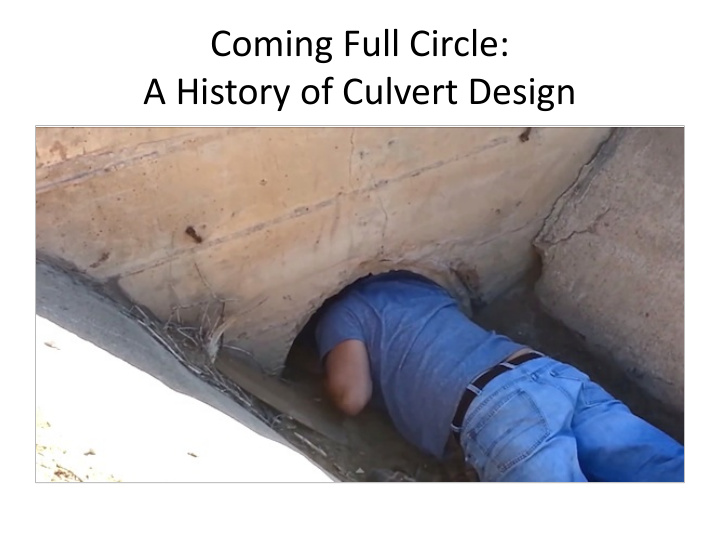



Coming Full Circle: A History of Culvert Design
The earliest culvert designs were based on the time it took for a horseback rider to traverse the watershed
The earliest empirical methods advocated for oversized designs “Size must be proportional to the greatest quantity of water which can ever be required to pass, and should be large enough to admit a boy to enter to clean them out.” Gillespie, A Manual of the Principles and Practices of Roadmaking 6 th ed., 1853:
The next step was to consider economics and appropriate sizing “Any one can make a culvert large enough, but it it the province of the engineer to design one of sufficient but not extravagant size” Byrne, A Treatise on Highway Construction 4 th ed. 1902:
With Dun’s table in the 1900s, empirical methods became slightly more sophisticated Still no hydraulic considerations
In 1851, we were introduced to the rational method that we still use today Hydrology: Rational Method: Q = CiA First described by Irish engineer Thomas Mulvany in 1851, didn’t see widespread use until much later Hydraulics considered, but no inlet/outlet control
Increasingly better data • Recurrence Intervals! • Based on frequency analysis of streamflow and/or rainfall data
Groundbreaking research in 1926 introduced modern culvert hydraulics Bureau of Public Roads and University of Iowa: • Introduction of CMP – pay more attention to roughness coefficient • Consider inlet/ outlet control
Modern Methods - Hydraulics 1950s and 60s: FHWA publishes “Hydraulic Charts for the Selection of Highway Culverts” These nomographs underpin HY8 software
So where are we today? Road Stream infrastructure infrastructure that passes that passes water vehicles
Beyond hydraulic capacity, what about fish and other creatures?
Native Hobbits?
Stream Simulation • The culvert is wide enough to span the natural stream plus bank • If the is stream is representative or “simulated”, then it should not represent a barrier to fish • Stream is allowed to migrate a little
Full Circle WDFW Water Crossing Design Guidelines (2013): “By measuring the channel width, one takes a measure of the watershed, its area and rainfall, its vegetation and substrate. Thus the channel width acts as a surrogate for the hydraulic analysis”
Tait River 1935
Tait River 1955
Tait River 2001
What about cost/benefit? • Wisconsin Department of Natural Resources, conventional vs. stream-simulation • Net fiscal benefit -$4,500 • Net social benefit +$7,800
Social benefits • Longer expected lifetimes • Reduced maintenance costs • Reduced catastrophic failure costs • Decreased flood-related physical costs • Wetland restoration benefits • Increased fish passage • Improved water quality • Reduced road user costs
Spare Slides
Problems with Modern Methods Do not consider changes in hydrology or sediment supply Do not consider the dynamic nature of natural streams
• Typically would only account for adult salmon, at certain times of the year • No consideration for juveniles or other aquatic organisms
Recommend
More recommend